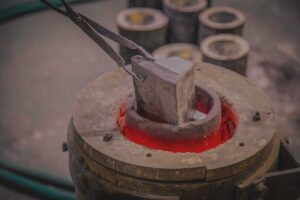Sure we see aluminium or products made of aluminium around us in our daily lives, but little do we know about the value chain of the metal. So, this is the space today to get acquainted with aluminium, talking of which ingot is the pure form of metal cast into a shape suitable for further processing. Aluminium ingots are heated past its melting point and cast into a bar or block using a mold chill method. Molds are available in different shapes and sizes, lending ingots a variety of appearances.
Now when we know what aluminium ingot is, let us learn how they are made. In the cast house, crucibles of molten aluminium empty their silvery liquid either directly into molds or into a holding furnace where the metal is kept molten at temperatures between 1200 and 1500 degrees Fahrenheit. Then 400kA electrical currents are passed through the mixture to break the bond between the aluminium and oxygen. The result is 99.8% pure aluminium.
The process of casting aluminium ingots takes place through majorly two routes – either from alumina through primary aluminium or the fusion and refining of aluminium scrap. Ingots obtained through the first type of process are called primary ingots and the second type is called secondary ingots. Depending on the purity of ingots, they can also be pure or alloy ingots.





1 comment
Hi, this is a comment.
To get started with moderating, editing, and deleting comments, please visit the Comments screen in the dashboard.
Commenter avatars come from Gravatar.
Comments are closed.